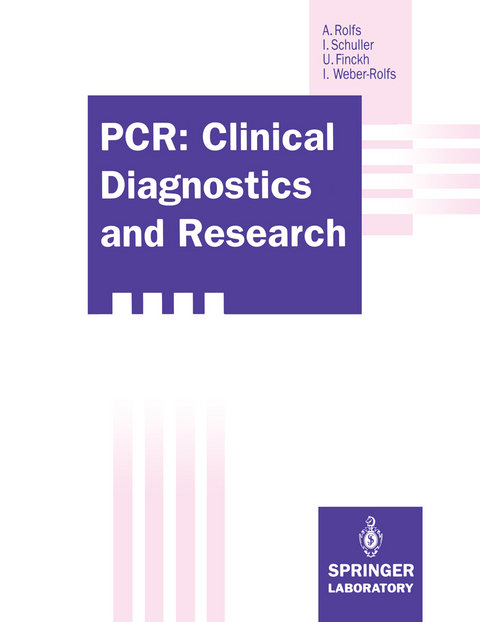
PCR: Clinical Diagnostics and Research
Springer Berlin (Verlag)
978-3-642-77494-2 (ISBN)
1. PCR: principles and reaction components.- 1.1. PCR: A cyclic, exponential, in vitro amplification process.- 1.2. Temperature and time profile of thermal cycling.- 1.3. Taq DNA polymerase and reaction buffer.- 1.4. Deoxynucleotide triphosphates (dNTPs).- 1.5. Primers.- 1.6. Oil overlay and reaction volume.- 1.7. DNA sample.- 1.8. Size and structure of amplification products.- 1.9. PCR set-up strategies.- 2. Optimization strategies.- 2.1. Analytical PCR.- 2.2. Preparative PCR.- 3. General applications of PCR.- 3.1. Asymmetric PCR.- 3.2. Allele-specifîc amplification (ASA).- 3.3. Nested PCR.- 3.4. Multiplex PCR.- 3.5. Differential PCR.- 3.6. Competitive PCR.- 3.7. Amplification of unknown sequences.- 3.8. Application of PCR for genetic examinations, DNA amplification fingerprinting.- 3.9. Amplification with consensus primers.- 3.10. Expression PCR.- 3.11. Detection of infectious agents or rare sequences.- 4. Substances affecting PCR: Inhibition or enhancement.- 4.1. Inhibition introduced by native material.- 4.2. Inhibition introduced by reagents during DNA isolation: Detergents, Proteinase K and Phenol.- 4.3. Additives influencing the efficiency of PCR.- 4.4. Evaluation of the effect of individual additives.- 5. PCR: Contamination and falsely interpreted results.- 5.1. Control experiments.- 5.2. Sources of contaminations.- 5.3. Prevention and elimination of contamination.- 6. Biological material amenable to PCR.- 6.1. Sample preparation and storage.- 7. Isolation of DNA from cells and tissue for PCR.- 7.1. Alkaline lysis.- 7.2. Guanidinium rhodanid method (GuSCN).- 7.3. Proteinase K digestion for the isolation of DNA.- 7.4. Automated DNA extraction.- 8. Isolation of RNA from cells and tissue for PCR.- 8.1. General preparations.- 8.2. Inhibition of endogenous RNases.-8.3. Methods for the isolation of RNA suitable for RT-PCR.- 9. Reverse transcription/PCR (RT-PCR).- 9.1. Setting up an RT-PCR.- 9.2. Selective RT-PCR.- 10. Methods for identification of amplified PCR products.- 10.1. Agarose gel electrophoresis.- 10.2. DNA blot transfer and nonradioactive hybridization /detection.- 10.3. Detection systems of digoxigenin labeled hybrids.- 10.4. Polyacrylamide gel (PAGE) electrophoresis.- 11. Restriction fragment analysis.- 11.1. Restriction endonucleases.- 11.2. Endonuclecase selection.- 11.3. Optimal digestion conditions.- 12. Multiplex PCR.- Method: Detection of three different mycobacterial genom regions in a single PCR tube.- 13. Detection of single base changes using PCR.- 13.1. Allele-specific amplification (ASA, PASA, ASP, ARMS).- 13.2. Allele-specific oligonucleotide hybridisation (ASO).- 13.3. Chemical mismatch cleavage method.- 13.4. Denaturing gradient gel electrophoresis (DGGE).- 13.5. PCR single-strand conformation polymorphism (PCR-SSCP).- 14. Non-radioactive, direct, solid-phase sequencing of genomic DNA obtained from PCR.- 14.1. Generation of single-stranded DNA fragments.- 14.2. Sequencing of biotinylated PCR products.- 15. Application of PCR to analyze unknown sequences.- 15.1. Inverse PCR.- 15.2. Alternative methods to inverse PCR.- 16. Quantification of PCR-products.- 17. Cloning methods using PCR.- Method: Cloning and purification of a partial gag-sequence of HIV-1 using PCR.- 18. Site-directed mutagenesis using the PCR.- 19. In-situ polymerase chain reaction.- 20. Oligonucleotides in the field of PCR.- 20.1. Guidelines for designing PCR primers.- 20.2. Synthesis of primers.- 20.3. Purification of oligonucleotides.- 20.3. Chemical modification of primers.- 21. Review of different heat-stable DNA polymerases.- 21.1.Taq DNA polymerase.- 21.2. Vent polymerase (Thermococcus litoralis).- 21.3. Thermus thermophilus DNA polymerase.- 21.4. Pfu DNA polymerase (Pyrococcus furiosus).- 21.5. Bst polymerase.- 21.6. Fidelity of different heat-stable DNA polymerases.- 22. Physical features of thermocyclers and of their influence on the efficiency of PCR amplification.- 23. Alternative methods to PCR.- 23.1. Ligase chain reaction (LCR).- 23.2. Transcription-based amplification system (TAS).- 23.3. Self-sustained sequence replication (3SR).- 23.4. Q-beta replicase.- Addendum: Methodological examples for the application of the Polymerase chain reaction.- A) Characterization of oncogenes.- B) Detection of infectious agents.- C) Basic methodology and research applications.- Appendix I: Suppliers of specialist items.- Appendix II: List of Contributors.- Appendix III: DNA sequencing chrornato grams.
| Erscheint lt. Verlag | 23.12.2011 |
|---|---|
| Reihe/Serie | Springer Lab Manuals |
| Zusatzinfo | XIX, 367 p. |
| Verlagsort | Berlin |
| Sprache | englisch |
| Maße | 210 x 280 mm |
| Gewicht | 964 g |
| Themenwelt | Naturwissenschaften ► Biologie ► Biochemie |
| Naturwissenschaften ► Biologie ► Zellbiologie | |
| Schlagworte | DNA • DNA amplification • DNA sequencing • Molekularbiologie • PCR • Polymerase • Polymerase chain reaction • Sequenzanalyse |
| ISBN-10 | 3-642-77494-6 / 3642774946 |
| ISBN-13 | 978-3-642-77494-2 / 9783642774942 |
| Zustand | Neuware |
| Haben Sie eine Frage zum Produkt? |
aus dem Bereich


